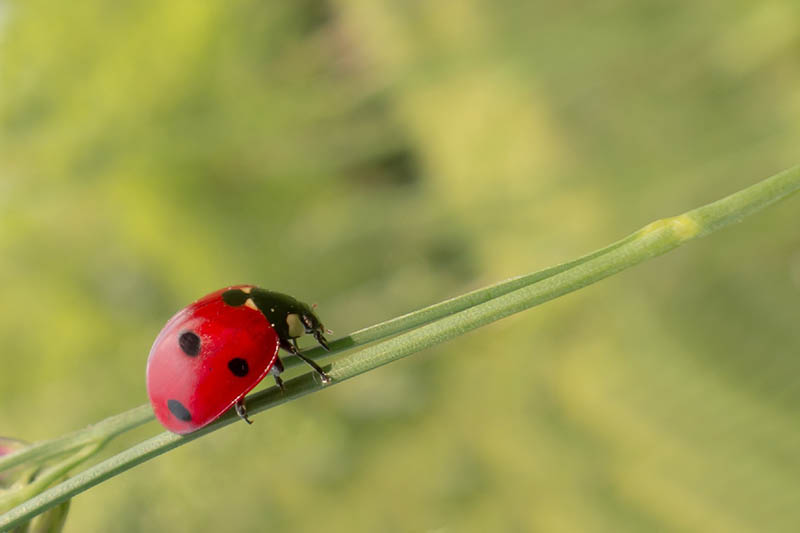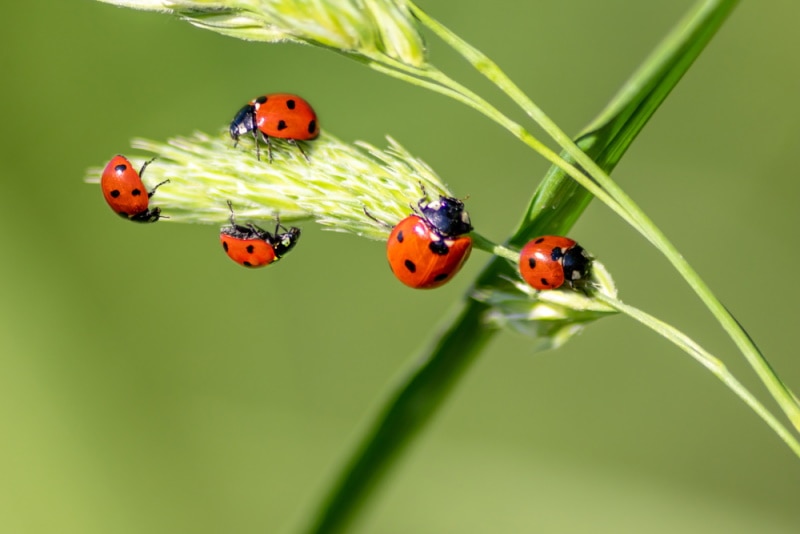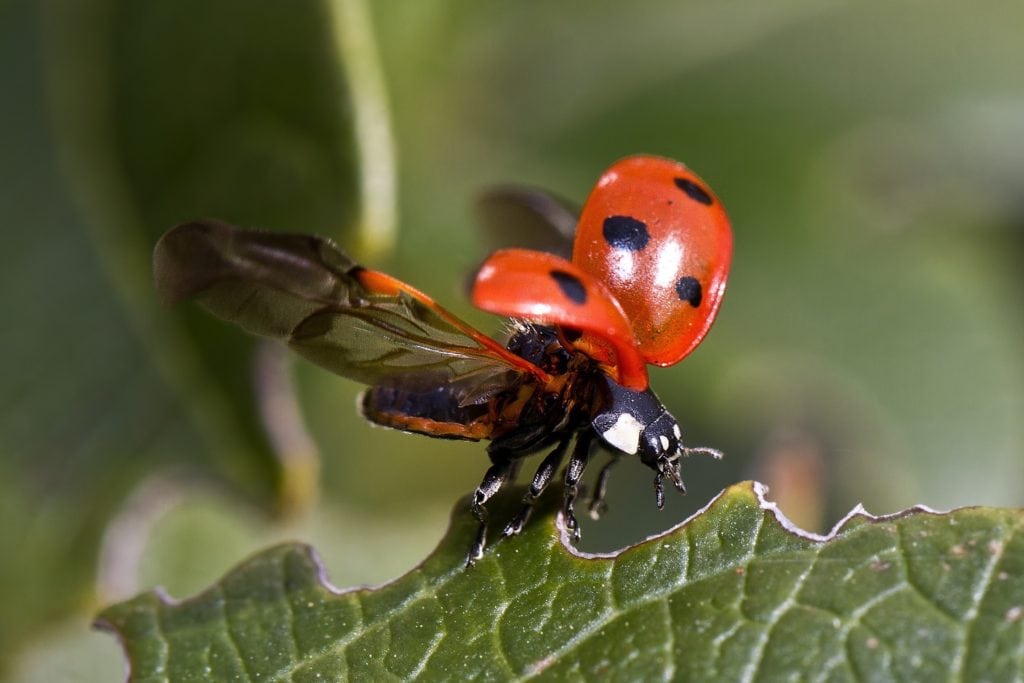Are Ladybugs Good for Plants? Reasons, Factors, & FAQ
-
Pete Ortiz
- Last updated:

In agriculture, ladybugs (also known as lady beetles or ladybirds) have always been a welcome sight. Why is that, though? Well, what’s the biggest nightmare for any gardener? If you like to grow veggies, fruits, and flowers in the backyard, your answer will probably be aphids, scales, and mealybugs. But for ladybugs, these pests are the top snack: they eat 50–60 aphids a day! Ladybugs are also great pollinators.
And that’s exactly why they’re often called the Gardener’s Apprentices. So, if you plant the right kind of flowers around the property and keep predators at bay, your garden will always be filled with hundreds, if not thousands, of these lovely beetles. Read on to learn about the ladybug diet, natural predators, and favorite plants!
| Botanical Name: | Coccinellidae |
| Type, Diet: | Invertebrates, omnivores (most species) |
| Ladybirds Feed On: | Aphids, scales, mealybugs |
| Average Lifespan: | 1–3 years (in the wilderness) |
| Average Adult Ladybug Size: | 0.3–0.4 inches |
| Natural Habitat: | Grasslands, forests, suburbs |
Bugs or Beetles? A Quick Look at Ladybugs
Despite the modest size of 0.3–0.4 inches and the cute, dotted bodies, ladybugs are quite tough. And, while a small percentage of ladybugs feed on plant leaves, most species prefer to chew on the flesh of other insects. The list includes aphids, mites, whiteflies, and scales, to name a few. But the question still stands if these tiny creatures are considered bugs or beetles?
Despite what the name suggests, they’re NOT bugs, but rather beetles. Their heads are partly hidden and come equipped with short, sturdy antennas that help with navigation. On top of that, adult ladybugs have two sets of wings: the ones that we see (mostly red with black dots) serve as a protective layer for the flight wings.
Habitat, Diet, and Lifespan

Ladybugs don’t live for that long (1–3 years when well-fed and sheltered) yet can eat up to 5,000 pests in their lifetime and lay over 1,000 eggs. You’ll mostly find ladybugs in forests, grasslands, meadows, suburban areas, and even big cities. But, since their main sources of food are located around plants, lady beetles are common guests in gardens and farms.
Primarily, we’re talking about aphids—the #1 snack for ladybird beetles. The diet includes both adults and eggs/larvae. In the US and Canada, the most popular ladybug species is the Coccinella ladybug, commonly known by its “street name”, the seven-spot ladybug. It’s got a rounded red back with seven black dots.
How Do Ladybugs Aid in Plant Growth?
If you have a large enough group of lady beetles in the garden, they’ll help solve two issues at once. First, they’ll eat all the aphids in the area. These pests are quick to reproduce and wreak havoc on the crops by drinking the sap and leaving the plants to die. But they don’t stand a chance against lady beetles, and the fewer destructive bugs in the backyard, the higher your crop yields will be.
Second, ladybirds are among the best pollinators Mother Nature has to offer. They are big fans of pollen and carry it from one plant in the garden to another. As you can imagine, this aids in flower, vegetable, and fruit growth. So, there you have it: fewer pests and more pollen. That’s how ladybird beetles help around the garden!
Can They Damage the Crops?

There are over 6,000 ladybug species on the planet. And, lucky for us, 99% of them only eat pests and pollen. These energetic, ever-busy insects spend most of their time looking for aphids to snack on and flowers with the best pollen. After that, they search for a mate to reproduce with and a place to use as a shelter for the winter.
So, no, lady beetles won’t be a concern around the garden, except for the Epilachninae ladybugs. Known as vegetarian ladybugs, they eat plant leaves. Furthermore, a small number of Epilachninae herbivores devour the crops, damaging the plants and leading to lower crop yields. The Mexican bean beetle is a good example of that. But it’s rather an exception to the rule.
Attracting Ladybugs to Your Garden: Tips and Tricks
You don’t have to do much to turn your garden into a magnet for ladybugs. They are attracted to dandelions, mulberry, dill, fennel, goldenrod, roses, geraniums, and many other flowers. The reason: they find their pollen to be especially delicious. As for vegetables, eggplants, cucumbers, tomatoes, and peppers are your best bet. Flowers are more effective at attracting ladybugs, but veggies will work as well.
This is important: sometimes, no matter how much effort you put into attracting lady beetles, they don’t show up. Maybe there’s a more opulent farm nearby or maybe there aren’t that many red-winged insects in the area, to begin with. If that’s the case, you can always buy a bunch of ladybugs at a local store. It will cost $15–20 (for a pack of 1,500) and help control the aphid population.
Why Do Ladybirds Have Spots?
Lady beetles are easily recognizable thanks to their “trademark” color pattern: red bodies and black spots. However, that’s not the only combination—far from it. Depending on the species, the body can be black with red spots; then there are ladybugs with yellow and orange bodies. The color of the dots differs as well. So, what’s the point of it all?
While we see this texture as a sign of beauty, most predators are discouraged by it. That’s right: these markings show potential lady beetle hunters that they’re toxic and have a foul taste. And the more spots there are on the back, the less palatable the ladybug will be in the eyes of the predator. This is called aposematic coloration, a technique commonly used by butterflies.
Smelly Toxins to the Rescue

The “unappetizing” coloring isn’t the only predator remedy in the arsenal of a ladybug. It can also release a toxin that smells bad and scares most birds and insects away. Don’t worry: these toxic fluids are not dangerous for a human (even for a child). They are, however, quite effective at spoiling the appetite of the hunters.
Birds and Wasps: Common Ladybug Predators
Speaking of predators, let’s take a quick look at the creatures that feed on lady beetles. We already talked about the pests that ladybugs use in their diet, so now it’s time to learn about the insects and animals that hunt them instead. The list isn’t that long. Still, if you want to make your garden a safe place for them, it’s important to know about the natural ladybug predators:
- This is the scariest group of predators. First, birds are big, fast, and strong. Second, they can spot these tiny, round-backed insects from a distance, which makes it very hard to hide from them. Swallows, crows, and swifts are the biggest fans of ladybug flesh.
- Mostly, we’re talking about the Joro and cellar spiders. However, since ladybugs have quite a sturdy skeleton, for many spiders, they are almost impossible to chew on. Besides, what most people don’t know is that lady beetles snack on spiders as well (especially spider mites and their eggs).
- Frogs/dragonflies. It doesn’t take much effort for frogs (mostly the tree frogs) to capture and devour ladybugs if they’re standing close. As for dragonflies, they grab the beetles in mid-air. How is this possible? Well, dragonflies are much faster and more flexible than lady beetles.
- When aphids eat the sap from plants, they produce honeydew. Ants use it as their primary food source. So, when ladybugs try to eat aphids, ants fight them off. Sometimes, they kill the beetles and feed on them instead. But technically, ants don’t hunt the dotted insects on purpose unless they’re extremely hungry.
- Parasitic wasps. Instead of eating a ladybug, the Dinocampus coccinellae wasp injects a parasitic egg into its body. The egg then feeds on the poor thing and develops from the inside, using the powerful shell of the lady beetle for protection against potential predators.
- Assassin bugs. These insects are equipped with a powerful proboscis that can penetrate the body of a lady beetle (or any other insect that they feed on). That’s how assassin bugs eat: they puncture the skeleton and wrench out the insides of their prey. It’s another horrible way for a ladybug to die!
Conclusion
Even if you’re a seasoned gardener, pests can still be a nuisance. This is especially true when you don’t want to use insecticides. Fortunately, we can always get ladybugs to help control the infestation. Adult lady beetles make short work of destructive insects, eating up to 5,000 pests in their lifetime. As a bonus, they’ll help pollinate the plants.
And, since most ladybugs only feed on aphids and pollen, you won’t have to worry about them damaging the crops. So, as far as the best natural remedies against pests go, ladybird bugs are right there on top of the list. Take proper care of them and watch the pest population shrink in front of your eyes!
Featured Image Credit: JumpStory
Contents



